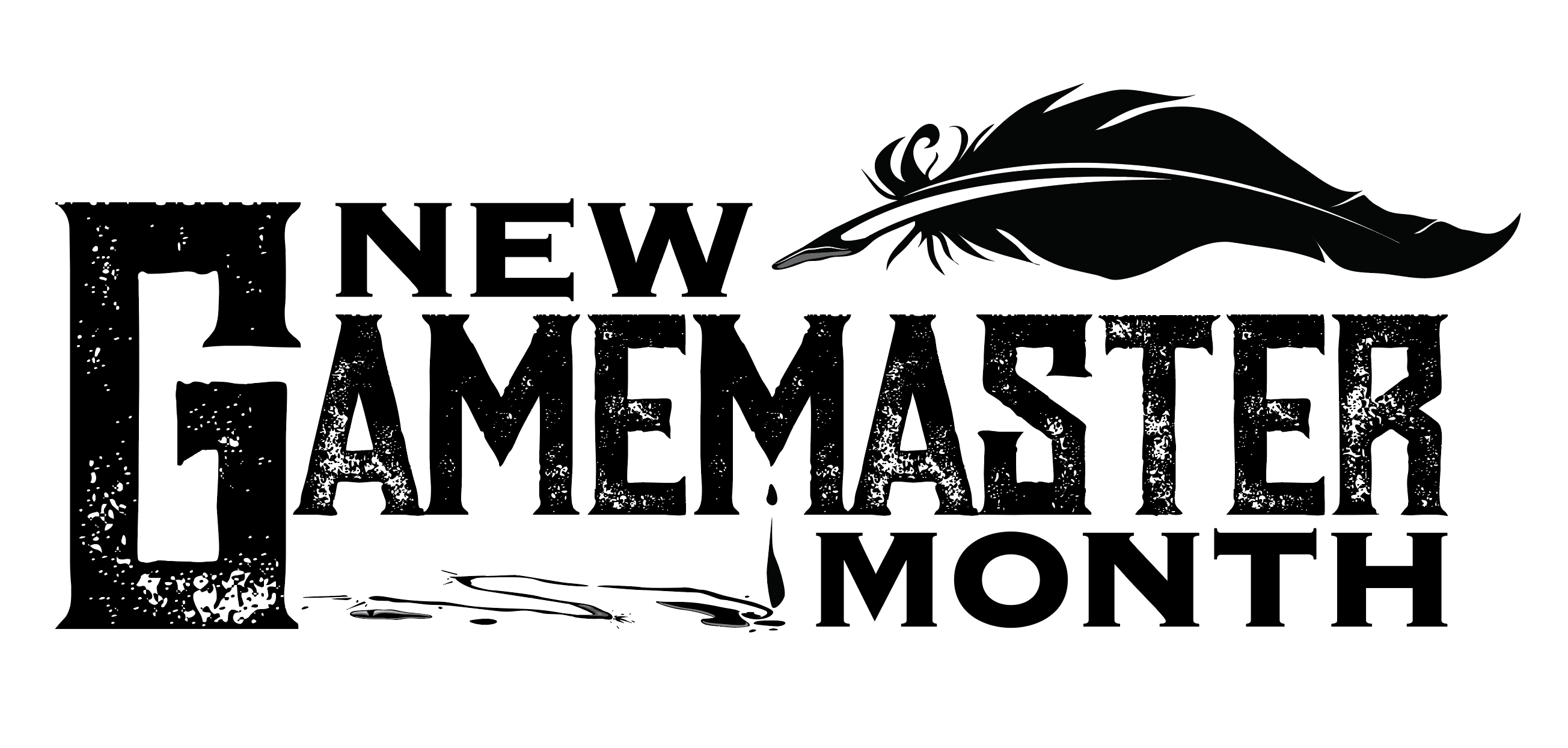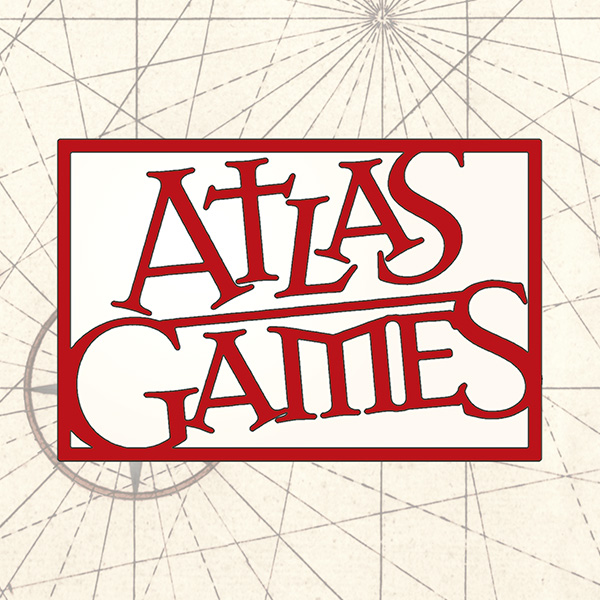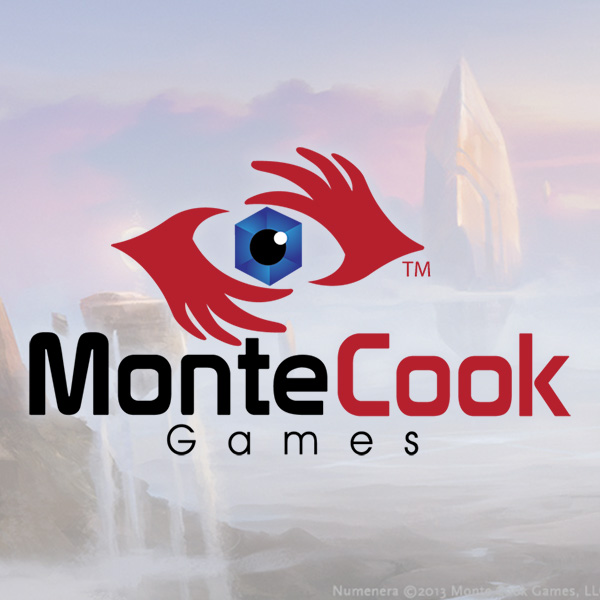Welcome to week three of New Gamemaster Month! If you’re just jumping in, don’t fret—it’s not too late. You have a bit of catching up to do, but nothing you can’t handle. More on how to catch up at the bottom of this post.

In New Gamemaster Month we’re helping players who feel the urge to run an RPG—to become a GM for the first time—take the plunge. If you’re just joining us, start with the first installment. Then join us every Tuesday and Thursday throughout January, and by the end of the month you’ll be a GM too!
This week we continue to explore the rules and setting, and develop our thinking about the adventure.
Encounters!
First, let’s talk about encounters. Encounters, sometimes referred to as scenes, are the meat of your adventure. As mentioned last week, an encounter is a point in your adventure where something happens, and usually where the characters (and players) take action, make decisions, learn something, or otherwise move the story forward. Encounters can take many forms:
- The characters kick down the dungeon door, find a monster within, and fight it to get its treasure.
- The characters are in a busy market when a beggar attempts to pickpocket them.
- The duke summons the characters to carry a message of peace to his rival.
- The characters have come to a rocky ravine in their travels—is it just a difficult climb, or are there enemies waiting to ambush them while they’re vulnerable?
- The characters break into the office of an erstwhile employer, searching for papers or other evidence of the employer’s true motives.
- And so on.
An encounter has some of the same elements as an adventure: An initial situation, a compelling hook or reason for the players to care, maybe a bit of mystery, and sometimes a turning point in the middle, where suddenly things are not what they at first seemed. Good encounters leave the outcome—and the means by which the characters resolve the encounter—open-ended.
The bulk of your GMing time will be spent running encounters; you’ll generally gloss over the in-between times, because that’s not where important things are happening. The characters spend a week in town, resting up and gathering supplies for the next leg of their journey? You spend five minutes telling them what makes the town unique, and maybe some of the interesting people there, and the results of their foraging efforts. Maybe you’ll go into more detail if something important begins to unfold—that’s basically an encounter evolving spontaneously—but mostly it’s quick exposition. Then the characters set out, and again you cover several days of activity in three or four minutes. But when the wolves attack their campsite at night, you shift back into encounter mode. Now the players act and react, and you resolve their actions on a moment-by-moment basis.
Encounters aren’t the only place your players make decisions. As the party travels through the wilderness, they might come to a fork in the road. Go east, or turn north? It’s a decision—and maybe an important one—but it doesn’t necessarily mean it has to be an encounter.
Generally speaking, the higher the proportion of encounter time to non-encounter time in your game, the better the pacing is likely to feel. But that doesn’t mean you should rush your players when they need time to consider their options or just take in the atmosphere of the game.
We’ll talk more about encounters in our next post, but for now we’re going to shift gears and go back to looking at the rules and setting.
Running Your First Game Virtually
In-person RPG sessions traditionally run for several hours at a time. The four-hour time slot is the norm at gaming conventions, and many groups typically play for that long, or even a couple of hours longer, at a sitting.
But many people find it fatiguing to spend long hours online—particularly if they’re already spending many hours a week in online classes or work meetings. Fortunately, the commute to an online game is short and easy: nobody has to pack up all their gaming supplies and drive halfway across town in rush-hour traffic to join the game. That sometimes makes it easier to run games more frequently, or on shorter notice.
So if you or your players suffer from “Zoom fatigue,” don’t feel tied to the traditional four-hour-plus game session. Nothing says you can’t play two evenings in a row, for a couple of hours each, instead.
Last Tuesday we started in on the basic game rules and setting. This time we’re going to read some more detailed rules on adjudicating play during an action-oriented encounter and have a look at some of the specific setting elements that form the background of your adventure, Taker of Sorrow.
Read this rules content:
- Chapter 8: Pages 116-117 (Start at the top of the second column, where it says Action: Activate a Special Ability, and stop when you get to the Long-term Movement header.)
- Chapter 8: Pages 119-120 (Start at Action: Wait and stop when you get to the Climbing header.)
- Chapter 8: Pages 122-128 (Start at Experience Points and read through the end of the chapter.)
And then read this setting content; it’ll put your mind into the region in which Taker of Sorrow is set:
- Chapter 10: Pages 136-141 (Navarene)
One last thing: Check in to the New Gamemaster Month Facebook group, if you haven’t already. We’d really love to hear how things are going for you, and in particular, we’d love to hear back from you when New Gamemaster Month is over and you’ve run your first game.
Catching Up?
If you heard about New Gamemaster Month a bit on the late side, it’s fine to jump in now. You’ll need to catch up with us, but that’s still quite doable. Start with the first post and read through them all. Each one gives you an activity, but for the most part they don’t take too long, so with a little effort you’ll be back with the class by our next blog post on Thursday—and on the road to running your first game in just a couple of weeks!
To simplify your activity list, here’s everything we’ve done so far, gathered into one easy checklist. Please note that this is just a cheat sheet, to make it a bit easier to keep track of what you’re doing—read the blog posts for the context you need to get the most out of these activities.
- Get your hands on a copy of Numenera Discovery.
- Decide when and where you will run your first game session.
- Reach out to half a dozen players and confirm the time and place with them.
- Read Part 1 of Numenera Discovery (beginning on page 11).
- Watch the How to Play Numenera video.
- Read pages 100-110 of Chapter 8 (stop when you get to the header that says Ambient Damage).
- Read all of Chapter 9 (beginning on page 130).
- Read Taker of Sorrow (beginning on page 363).
- Chat briefly with your players about what they like and expect out of an RPG, and maybe share some of the hooks or info about shin obligation with them.
As discussed last Tuesday, the objective and its path are created collaboratively. But the encounters that make up each game session are made by you, the GM. That’s because Unknown Armies is a game about mystery, and it’s hard to find that in scenes the players helped create.
Obstacles, Distractions, and Blowbacks
As the GM, you will create encounters either before each game session or improvisationally as each session unfolds. Because this is your first time being a GM, it’s probably better to stick with planning them ahead of time. (But don’t worry about planning them right now—we’re just familiarizing you with the concepts at this point.)
In Unknown Armies, there are three types of encounters that make up the game: obstacles, distractions, and blowbacks.
Obstacles are pretty simple. They are encounters that block the cabal from reaching their objective. If the objective is, “Eliminate crime and corruption in our hometown,” example obstacles could be career criminals, corrupt politicians, or even groups like Ordo Corpulentis. They could also be gambling houses, automotive chop shops, or similar locations. Whatever stands on the path to prevent milestones from being reached makes for great encounters.
A distraction is like a side quest. It’s an encounter that doesn’t completely line up with the objective. Instead, it helps build a character’s personal story, such as an adept who needs some magickal mojo to cast a powerful spell. After all, the objective isn’t always more important than the people chasing it
To make a distraction work, think about what the players’ characters want that can get in the way of the group’s objective. Then create an encounter that offers that. If the cabal is working to end crime and corruption, offer one player something their character would kill for — as well as the opportunity to literally do just that. This builds the drama and makes the game tense. Just don’t go crazy using distractions or the main objective can get lost.
As you get through a few game sessions, the characters will start creating enemies and problems. Taking down a corrupt cop could anger her buddies on the force, the local criminals that she protected, and so on. These complications are called blowbacks, and are another great type of encounter you can build. As with distractions, use them sparingly, but definitely use them. They help the setting come alive — and help players realize that their choices can have unintended consequences.
Catching Up?
If you are new to the Unknown Armies side of New Gamemaster Month, welcome! Don’t worry, everything previously discussed is still there, ready for you to read. Go back to the first post about getting started. To summarize:
- Get a copy of the first three Unknown Armies books or PDFs. They are Book One: Play, Book Two: Run, and Book Three: Reveal.
- Skim the rules and setting info to get a grasp on what Unknown Armies is about.
- Find three to five other people to play, then discuss where and when to meet regularly.
- Read up on how to roll percentile dice in Unknown Armies.
- At the first session, talk with players to determine what everyone wants from the game. Use that to create the group’s objective.
Next time, we’ll discuss how to add details that make Unknown Armies feel weird and scary.
Last Tuesday we started in on the basic game rules and setting. This time we’re going to read some more detailed rules on adjudicating play.
Read this content:
- The rules for Fighting, Stability and Sanity Loss, and Refreshing Ability Pools on pages 60-82. The combats in Midnight Sub Rosa are relatively simple ones, so you don’t need to worry too much about special-case rules like rate of fire or cover.
- The Character Creation Quick Reference on p. 9.
One last thing: Check in to the New Gamemaster Month Facebook group, or tweet us at @NewGmMonth, if you haven’t already. We’d really love to hear how things are going for you, and in particular, we’d love to hear back from you when New Gamemaster Month is over and you’ve run your first game.
Catching Up?
If you heard about New Gamemaster Month a bit on the late side, it’s fine to jump in now. You’ll need to catch up with us, but that’s still quite doable. Start with the first post and read through them all. Each one gives you an activity, but for the most part they don’t take too long, so with a little effort you’ll be back with the class by our next blog post on Thursday—and on the road to running your first game in just a couple of weeks!
To simplify your activity list, here’s everything we’ve done so far, gathered into one easy checklist. Please note that this is just a cheat sheet, to make it a bit easier to keep track of what you’re doing—read the blog posts for the context you need to get the most out of these activities.
- Get your hands on a copy of the Trail of Cthulhu corebook.
- Download our sample scenario, Midnight Sub Rosa.
- Decide when and where you will run your first game session.
- Reach out to half a dozen players and confirm the time and place with them.
- Skim the Introduction of the Trail of Cthulhu corebook (pages 6-7), and…
- Read The Thirties chapter on pages 168-189
- Read Clues, Tests and Contests – pages 51-82
- Skim The Cthulhu Mythos: Pages 84-167
- Read Midnight Sub Rosa
- Chat briefly with your players about what they like and expect out of an RPG, and maybe share some information about the type of adventure they’ll be playing.
Last Tuesday we started in on the basic game rules and setting and got you started with the introductory adventure. This time we’re going to read some more detailed rules on adjudicating play during an action-oriented encounter and have a look at some of the specific setting elements that form the background of your adventure, “A Rough Landing.”
As noted before, the adventurers are sent to find an inn and arrive at a nearby market just as things are closing down. Some angry troll mercenaries are in the middle of trashing the market due to misfortune—no fault of their own!—that has left them angry at the people of the town. The town guard are nowhere nearby, and the merchants in the market turn to the player character adventurers for help.
Thus, the adventure begins with a simple opportunity for conflict, that can potentially be avoided with some clever roleplaying or even making a choice to stand down. This whole “scene”, with the setup, the antagonists, and the location, is an encounter.
There are many ways the adventurers can handle this.
- They can simply decide it’s not their problem and walk away. Those adventurers with Honor as a personal trait (a Passion) might find this to be out of character.
- They can step in and try to talk things down. This requires some Persuade and appeals to common sense, made more difficulty by the low skill in a shared language.
- They can threaten, which can send them using the Intimidate skill and presenting themselves as willing to dispense violence.
- They can simply jump into the fight, drawing their weapons and choosing targets, either trying to subdue or to kill the troll mercenaries.
Page 9 of the adventure has a sidebar called Your First Fight! with guidance about how to handle this sort of thing, and page 10 discusses strike ranks, the method to determine who goes first, second, third, etc.
One last thing: Check in to the New Gamemaster Month Facebook group, if you haven’t already. We’d really love to hear how things are going for you, and in particular, we’d love to hear back from you when New Gamemaster Month is over and you’ve run your first game. That’s where you’ll report it, and win a fabulous prize (well, a modest prize) as an expression of our congratulations.
Catching Up?
If you heard about New Gamemaster Month a bit on the late side, it’s fine to jump in now. You’ll need to catch up with us, but that’s still quite doable. Start with the first post and read through them all. Each one gives you an activity, but for the most part they don’t take too long, so with a little effort you’ll be back with the class by our next blog post on Thursday—and on the road to running your first game in just a couple of weeks!
To simplify your activity list, here’s everything we’ve done so far, gathered into one easy checklist. Please note that this is just a cheat sheet, to make it a bit easier to keep track of what you’re doing—read the blog posts for the context you need to get the most out of these activities.
- Get your hands on a copy of the RuneQuest Starter Set (and possibly the RuneQuest corebook, if desired).
- Decide when and where you will run your first game session.
- Reach out to no more than half a dozen players and confirm the time and place with them.
- Read the introductory information about Glorantha and the system basics in the Rules and The World of Glorantha booklets.
- Download and play through the SoloQuest, if possible.
- Read “A Rough Landing” adventure (Adventures booklet, pages 5–23).
- Chat briefly with your players about what they like and expect out of a roleplaying game, and maybe share some of the hooks or info about the world of Glorantha with them.
What Makes Up A Threat
Let’s look a closer look at the threats in our sample adventure, “Dream Away the Time”. In the last post, we covered the mystery concept (what is going on), the hook (why the hunters might get involved), and the countdown (what will happen if they don’t or if they fail). This the backbone of the mystery.
We also mentioned threats provide challenges to the hunters. Each threat has a different type:
- Monster: The creature to be defeated, Bonecruncher the redcap.
- Minions: It’s worth noting that the most dangerous supernatural being here (Oberon, King of Faerie) is not the monster. Oberon has set certain things in motion, but Bonecruncher is the immediate danger to the town and the hunters. Threat types are defined by their role in the mystery, which is why this one has Oberon as a “minion” even though he’s really in charge. Violet the Changeling is also a minion.
- Bystanders: Here, they are primarily the inhabitants of the town of Handfast—a dozen of them, and random tables to create more as needed as the hunters investigate.
- Locations: The locations in this adventure are the town of Handfast, the Tornado and Flood Wreckage from a recent event, the Crowne Tavern, the Handfast Children’s Park, the Old Forest Nature Reserve, and Oberon’s Fortress.
Each threat also has a motivation (as discussed in the last post) and may have a special move and/or a weakness. A special move describes a distinctive action that type of threat may take. For instance, bystanders may Go off alone, Argue with the hunters, Get in the way, and so on. Weaknesses are self-explanatory.
As the Hunters interact with threats, the adventure unfolds. In a typical episode, the Hunters:
- Hear about events caused by the monster (the hook)
- Investigate to discover the monster’s weaknesses (by interacting with bystanders)
- Meet some obstacles (locations and minions, escalating to the monster itself)
- Eventually have a showdown where they use what they learn in their investigation to take down the monster.
The hook and the showdown represent the beginning and end of the Mystery, but investigation and overcoming obstacles can be mixed into the game in any order in between. Instead of giving you a hard and fast plot to follow, the motivations and special moves of the threats serve as prompts to help you develop the mystery interactively as the players explore what’s going on.
Picking the type and motivation for each threat gives you a sense of how to use that threat, what it’s trying to do in anticipation, opposition, or reaction to the hunters’ actions. Each type of threat has its own set of special moves it can make. The threat type, its motivation, and special moves are all there to help suggest to you the kinds of interesting things the threat might do in response to the actions of the hunters.Use these threat elements in conjunction with soft and hard moves when you need to describe what a threat is doing.
Sections to Read and Review: Introductory Mystery: Dream Away the Time (pages 149-161); Threat Moves (pages 176-179).
If You’re Using Roll20
When creating threats in the Keeper’s Mystery Sheet, you will notice that selecting different types of threats reveals different options. For example, monsters and minions have a space for powers but bystanders and locations don’t. Some types of information fields behave in special ways:
- Adding a power, attack, or weakness to a list will cause another field of the same type to open immediately below so you can keep adding more.
- Adding a move opens sub-items as a bulleted list so you can list what happens on a roll result of 10and above, 7 to 9, or 6 or less.
- Name, description, armour, and notes fields are simple text fields.
Not all of these fields need to be filled either: some minions don’t have powers, for example, and most bystanders don’t have a harm capacity or custom move. Take only what you need to survive!
Wise Delta Green Agents avoid the unnatural whenever possible. They do not “encounter” the unnatural. They ambush it. They bury it. They smother it in its crib. Fights are never fair and the winners are the first to cheat. If the unnatural threat knows about the forces arrayed against it and has a chance to respond? Something has already gone terribly, irreversibly wrong.
Last week’s actionables were about developing a plan for the scenario.
- Primary Objective A: Sketch a mind map with all the scenes in “Last Things Last” (post office, apartment, and cabin)
- Primary Objective B: Write a cloud of details from the text and your own imagination around each scene. These tags should be used in descriptions of that scene to enhance the mood of the game.
- Primary Objective C: Connect the three scenes with a single plot line, made up of clues the characters can’t miss.
- Secondary Objective: Download and study the flowcharts contained in this entry, if you don’t want to make your own.
This week is about the plans of the Agents: specifically, what happens when they go wrong. Wise Agents avoid danger. When that fails, threats to their sanity and safety must be tracked by the Handler.
Familiarize yourself with the rules of combat and sanity on pages 34–37.
In “Last Things Last,” the Agents are unlikely to have run-ins with other armed characters. That means most combat encounters are likely to be determined by a Firearms test against an unarmed opponent (no Dodge roll allowed) or a Melee Weapons or Unarmed test against another character’s Dodge roll (see “Opposed Rolls” on page 33). In fact, combat is only likely when they face Marlene (page 45). If something else goes down, assume an NPC combatant has any skill they need at 40%.
The physical encounters Agents face closely mirrors the threats to their sanity.
As you know from page 36, there are three threats to Sanity Points: violence, helplessness, and the unnatural. Those categories also neatly describe the physical threats they face.
Threats from violence tend to come from other humans or the environment.
Of course, the Unnatural can be very violent, too. But Agents often come into conflict with other humans who assist or are influenced by the unnatural threat. For instance, if the Agents decide Mrs. Janowitz (page 43) knows too much and must be killed, the threat to their sanity will come from violence, as well as whatever physical means Mrs. Janowitz uses to defend herself—or, if the Agents are incautious murderers, from neighbors or police responding to the crime.
Threats from helplessness tend to come from the danger of exposure.
Helplessness threatens an Agent who realizes that she left DNA evidence under the clawing nails of poor Mrs. Janowitz hours before. Helplessness strikes as the Agents nervously wait for the screams of a dying monster to stop (page 45). Helplessness threatens when Agents fear they won’t be able to escape the consequences of their actions or the doomed trajectory of life working for Delta Green.
Threats from the unnatural worsen all other threats.
In “Last Things Last,” that which was Marlene (page 45) is the main unnatural threat. Seeing or even understanding what Marlene has become damages an Agent’s Sanity Points. This corrupting effect is cumulative. The dangers to body and mind only get worse if Agents allow Marlene out of the tank (violence). If they burn the thing in its container, ignoring the pleas of an old woman begging for her life forever haunts them (helplessness).
In preparation for the Marlene encounter (and any other messes the characters might get themselves into), complete the following tasks this week.
Actionables
- Primary Objective: Read the combat and sanity rules on pages 34–37.
- Bonus Objective: Consider other possible threats to safety and sanity that Agents might invite upon themselves. Prepare accordingly.
Last Tuesday, we started on the basic Tales of the Valiant game rules and settings. Today, we’re looking into more detailed rules on adjudicating play during action encounters and some setting elements to keep in mind.
Begin by reading this content:
- Chapter 6: Encounter Game Play – Page 221–224
- Chapter 6: Combat Encounters – Page 225–235
- Chapter 7: Spellcasting – Page 239–245
If you’re looking for more inspiration and to earn extra credit, download the Guide to the Labyrinth for free and read the setting content; it’ll give you more information on the Labyrinth and inspire the adventure you’re going to run:
- DOWNLOAD GUIDE TO THE LABYRINTH
- Read Chapter 1: The Labyrinth – Pages 8–17
We’d really love to hear how things are going for you as you continue to play. Make sure to join the New Gamemaster Month Facebook page or the Kobold Press Discord to join in the conversation and hear from other up-and-coming Game Masters.
Catching Up
If you’re just hearing about New Gamemaster Month, now is a great time to jump in! You’ll be up to speed if you start with the first post and read through them in order.
Each one gives you an activity, but they fly by. Catch up and you’ll be on track for our next blog post on Thursday—and then on to running your first game in just a couple of weeks!
Here’s everything we’ve done so far, gathered into one easy checklist. Note that this is just a cheat sheet you can work from —read the whole blog posts for the context you need to get the most out of these activities.
- Get your hands on a copy of the Tales of the Valiant Players Guide and the Adventures of Dib PDF.
- Decide when and where you will run your first game session.
- Reach out to players and confirm the time and place with them.
- Read the Introduction of the Tales of the Valiant: Player’s Guide (pages 7–10).
- Watch a Tales of the Valiant actual play video on YouTube.
- Read pages 203–221 of Chapter 6 of the Players Guide.
- Read the Impregnable Fortress of Dib (pages 3–6 of the Adventures of Dib PDF).
- Chat briefly with your players about what they like and expect out of a roleplaying game. Share player options, and reveal some hooks or info about the adventure with them.
Encounters in Savage Worlds can be quick and bloody affairs. That said, heroes have quite a few ways to come out on top. The extra rules you need for combat are on pages 4-6 of the Test Drive, but you don’t even need all of them most of the time.
🎴 Action Cards
Rather than rolling for initiative, when combat begins, deal each of the characters a card from a standard Poker deck (called their Action Card). In this adventure deal one for the villains to go on. Whoever has the highest card (Aces are best, followed by King, Queen, Jack, 10, 9, etc.) acts first.
💡 Pro Tip: Once a character finishes acting, take their Action Card. Look around the table for the next highest card—that’s who’s up next. Players can see who’s up next too, which helps speed things up.
🛡️ Parry
Last week we said that most Trait rolls succeed with a roll or 4 or higher. Hand to hand combat is one of the exceptions. Instead of 4, the number is the target’s Parry (usually between 2-6). If a target’s Parry is 5, for example, a roll of 5 or higher hits and a 9 or greater is a raise. Ranged combat just uses the standard 4 to-hit. If you don’t want to get shot, find cover!
💥 Damage
Trait rolls take the single best die result, but a damage roll totals up all the dice together. Every die can Ace, so truly huge damage totals are possible. This is super fun when it happens for players against their foes, but terrifying when it happens to damage the players’ characters! Take a deep breath when that happens and encourage the targeted player to spend a Benny and roll Vigor to Soak the damage. Even if it doesn’t mitigate it all, every little bit helps. A player can spend another Benny and roll again hoping to do better. A lucky Ace or two absorbs a huge amount of damage!
Throughout this program, we have expert GMs on hand to answer questions and provide general support at the New Gamemaster Month Discord Server or the New Gamemaster Month Facebook group. Please drop in, join the group, introduce yourself, and ask any questions you might have. Other new GMs will also be there—it’s a great place to share your experiences and support one another. Hope to see you there!









Pingback: Routinely Itemised: RPGs #293